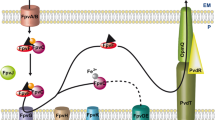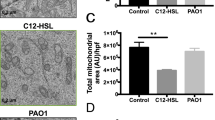Abstract
Glutathione (GSH) plays important roles in pulmonary diseases, and inhaled GSH therapy has been used to treat cystic fibrosis (CF) patients in clinical trials. The results in this report revealed that GSH altered the sensitivity of Pseudomonas aeruginosa to different antibiotics through pathways unrelated to the oxidative stress as generally perceived. In addition, GSH and its oxidized form inhibited the growth of P. aeruginosa.
Similar content being viewed by others
References
Djordjevic V B. Free radicals in cell biology. Int Rev Cytol, 2004, 237: 57–89, 15380666, 10.1016/S0074-7696(04)37002-6, 1:CAS:528:DC%2BD2cXhtVentL3M
Pastore A, Federici G, Bertini E, et al. Analysis of glutathione: implication in redox and detoxification. Clin Chim Acta, 2003, 333(1): 19–39, 12809732, 10.1016/S0009-8981(03)00200-6, 1:CAS:528:DC%2BD3sXksVOmt70%3D
Griffith O W. Biologic and pharmacologic regulation of mammalian glutathione synthesis. Free Radic Biol Med, 1999, 27(9–10): 922–935, 10569625, 10.1016/S0891-5849(99)00176-8, 1:CAS:528:DyaK1MXns1ymsr0%3D
Meister A, Anderson M E. Glutathione. Annu Rev Biochem, 1983, 52: 711–760, 6137189, 10.1146/annurev.bi.52.070183.003431, 1:CAS:528:DyaL3sXkvVektbs%3D
Schafer F Q, Buettner G R. Redox environment of the cell as viewed through the redox state of the glutathione disulfide/glutathione couple. Free Radic Biol Med, 2001, 30(11): 1191–1212, 11368918, 10.1016/S0891-5849(01)00480-4, 1:CAS:528:DC%2BD3MXjsFegt78%3D
Cantin A M, Hubbard R C, Crystal R G. Glutathione deficiency in the epithelial lining fluid of the lower respiratory tract in idiopathic pulmonary fibrosis. Am Rev Respir Dis, 1989, 139(2): 370–372, 2913886, 1:CAS:528:DyaL1MXhvFSht7o%3D
Roum J H, Buhl R, McElvaney N G, et al. Systemic deficiency of glutathione in cystic fibrosis. J Appl Physiol, 1993, 75(6): 2419–2424, 8125859, 1:STN:280:DyaK2c7ntFKnuw%3D%3D
Meister A. Glutathione deficiency produced by inhibition of its synthesis, and its reversal; applications in research and therapy. Pharmacol Ther, 1991, 51(2): 155–194, 1784629, 10.1016/0163-7258(91)90076-X, 1:CAS:528:DyaK38Xht1Shs7g%3D
Suntres Z E, Omri A, Shek P N. Pseudomonas aeruginosa-induced lung injury: role of oxidative stress. Microb Pathog, 2002, 32(1): 27–34, 11782118, 10.1006/mpat.2001.0475, 1:CAS:528:DC%2BD38Xit1ymtw%3D%3D
Griese M, Ramakers J, Krasselt A, et al. Improvement of alveolar glutathione and lung function but not oxidative state in cystic fibrosis. Am J Respir Crit Care Med, 2004, 169(7): 822–828, 14726422, 10.1164/rccm.200308-1104OC
Hartl D, Starosta V, Maier K, et al. Inhaled glutathione decreases PGE2 and increases lymphocytes in cystic fibrosis lungs. Free Radic Biol Med, 2005, 39(4): 463–472, 16043018, 10.1016/j.freeradbiomed.2005.03.032, 1:CAS:528:DC%2BD2MXmvVKgurg%3D
Albesa I, Becerra M C, Battan P C, et al. Oxidative stress involved in the antibacterial action of different antibiotics. Biochem Biophys Res Commun, 2004, 317(2): 605–609, 15063800, 10.1016/j.bbrc.2004.03.085, 1:CAS:528:DC%2BD2cXivVCrurk%3D
Cabiscol E, Tamarit J, Ros J. Oxidative stress in bacteria and protein damage by reactive oxygen species. Int Microbiol, 2000, 3(1): 3–8, 10963327, 1:CAS:528:DC%2BD3cXksVCnur0%3D
Goswami M, Mangoli S H, Jawali N. Involvement of reactive oxygen species in the action of ciprofloxacin against Escherichia coli. Antimicrob Agents Chemother, 2006, 50(3): 949–954, 16495256, 10.1128/AAC.50.3.949-954.2006, 1:CAS:528:DC%2BD28XisFamtL4%3D
Hoang T T, Karkhoff-Schweizer R R, Kutchma A J, et al. A broad-host-range Flp-FRT recombination system for site-specific excision of chromosomally-located DNA sequences: application for isolation of unmarked Pseudomonas aeruginosa mutants. Gene, 1998, 212(1): 77–86, 9661666, 10.1016/S0378-1119(98)00130-9, 1:CAS:528:DyaK1cXjvFSgu7Y%3D
Liang H, Li L, Dong Z, et al. The YebC family protein PA0964 negatively regulates the Pseudomonas aeruginosa quinolone signal system and pyocyanin production. J Bacteriol, 2008, 190(18): 6217–6227, 18641136, 10.1128/JB.00428-08, 1:CAS:528:DC%2BD1cXhtFSrs77L
Schweizer H P. Two plasmids, X1918 and Z1918, for easy recovery of the xylE and lacZ reporter genes. Gene, 1993, 134(1): 89–91, 8244036, 10.1016/0378-1119(93)90178-6, 1:CAS:528:DyaK2cXisVGgtg%3D%3D
Dickinson D A, Forman H J. Cellular glutathione and thiols metabolism. Biochem Pharmacol, 2002, 64(5–6): 1019–1026, 12213601, 10.1016/S0006-2952(02)01172-3, 1:CAS:528:DC%2BD38Xms1ymsb4%3D
Kohler T, Curty L K, Barja F, et al. Swarming of Pseudomonas aeruginosa is dependent on cell-to-cell signaling and requires flagella and pili. J Bacteriol, 2000, 182(21): 5990–5996, 11029417, 10.1128/JB.182.21.5990-5996.2000, 1:CAS:528:DC%2BD3cXns1ems7c%3D
Grant S G, Jessee J, Bloom F R, et al. Differential plasmid rescue from transgenic mouse DNAs into Escherichia coli methylation-restriction mutants. Proc Natl Acad Sci USA, 1990, 87(12): 4645–4649, 2162051, 10.1073/pnas.87.12.4645, 1:CAS:528:DyaK3cXkslantbg%3D
Novick R. Properties of a cryptic high-frequency transducing phage in Staphylococcus aureus. Virology, 1967, 33(1): 155–166, 4227577, 10.1016/0042-6822(67)90105-5, 1:STN:280:DyaF2s3ls1Wgtw%3D%3D
Tereschuk M L, Riera M V, Castro G R, et al. Antimicrobial activity of flavonoids from leaves of Tagetes minuta. J Ethnopharmacol, 1997, 56(3): 227–232, 9201613, 10.1016/S0378-8741(97)00038-X, 1:CAS:528:DyaK2sXktF2gtr0%3D
Author information
Authors and Affiliations
Corresponding author
Additional information
Supported by the National Natural Science Foundation of China (Grant Nos. 30870097 and 30611120520)
Rights and permissions
About this article
Cite this article
Zhang, Y., Duan, K. Glutathione exhibits antibacterial activity and increases tetracycline efficacy against Pseudomonas aeruginosa. SCI CHINA SER C 52, 501–505 (2009). https://doi.org/10.1007/s11427-009-0074-8
Received:
Accepted:
Published:
Issue Date:
DOI: https://doi.org/10.1007/s11427-009-0074-8




